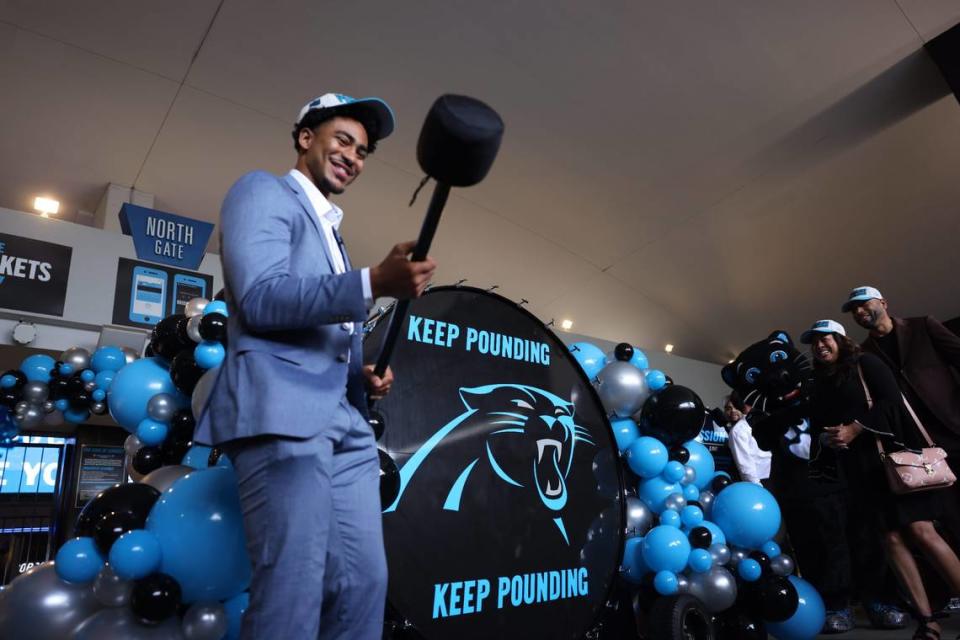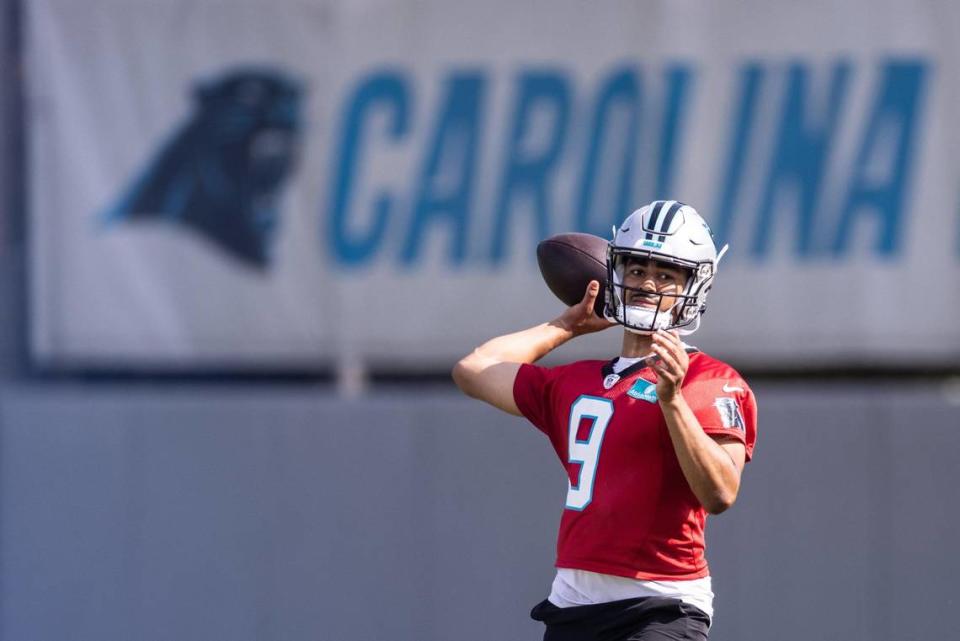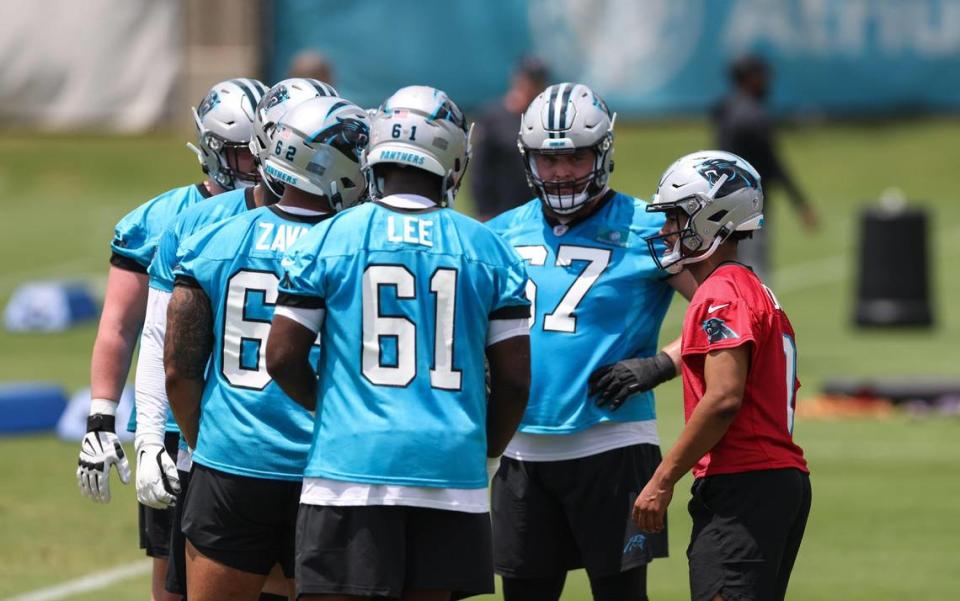Bryce Young is built for starting role: 5 takeaways on Panthers rookies
When Bryce Young steps onto the campus at Wofford College on Saturday, he’ll be asked to lead his first NFL training camp. And while he has been the top signal-caller at one of the best football programs in the country over the past two years, Young’s job in Spartanburg, S.C., will involve him guiding a brand new offense, surrounded by veteran teammates, some of whom are more than a decade older than him.
Young, the first overall pick in April, is the centerpiece of the Panthers’ overarching future. When Young and his fellow rookies reunite with coaches to begin camp — the majority of the veteran players won’t arrive in Spartanburg until Tuesday — they’ll jump-start the team’s self-evaluation process, which will ultimately lead to Carolina’s initial 53-man roster.
Young and the four other members of the rookie class — wideout Jonathan Mingo, pass rusher DJ Johnson, guard Chandler Zavala and safety Jammie Robinson — are fighting for roles instead of roster spots. With the class likely to stay intact throughout its collective rookie season, the group will look to provide the Panthers with immediate returns on their investments.
But, as with any young group, that’s easier written than done.
Here are five thoughts on Panthers’ rookie class ahead of training camp:
Bryce Young is built for the QB job where it counts
While much has been made about Young’s slight stature (listed as 5-foot-10 and 204 pounds), the former Alabama quarterback exhibited maturity, intelligence and leadership skills throughout spring workouts during the offseason program.
NFL history is littered with tall quarterbacks who failed because their mental intangibles weren’t up to par. Sure, Young is an extreme outlier when it comes to size, but his football IQ and work ethic, at least according to some pretty notable individuals, is up there with some of the great quarterback prospects of the past few decades.
Young stayed on the field after OTA workouts to improve his chemistry with his receivers. He impressed onlookers with his improvisational playmaking skills when defensive coverage won the initial battle in team drills. He also made the most of his study time behind the scenes by working diligently while he was away from Bank of America Stadium. Those actions, along with his tenacity, demeanor and arm talent, earned him rave reviews from teammates and coaches.
So, while Young isn’t your grandfather’s (or probably even your father’s) style of quarterback, the rookie signal-caller has the mental makeup and the passing prowess to win at the most important position in sports.
His size is obviously polarizing (understandably so), but two former NFL quarterbacks — head coach Frank Reich (listed as 6-4 during his playing days) and quarterbacks coach Josh McCown (also 6-4) — seem to have little issue with Young being, ahem, little. The former quarterback duo handed Young the baton to the offense midway through the offseason program, even with veteran Andy Dalton (listed as 6-2, if you care) respectably holding down the fort.
The best quarterbacks in the league win because they are able to improvise. Some are fluid because of their unique mobility at the position, while others thrive by out-thinking opposing defenses in the moment. While Young has an understated knack for picking up yardage with his legs, the former Heisman Trophy winner has routinely displayed the ability to slow the game down with his mind and make the right reads. His mind is what will ultimately help him lead the Panthers to victories during his career.
READ MORE: ‘This is surreal’: New Panthers quarterback Bryce Young arrives in Charlotte
Can Jonathan Mingo become ‘the guy’ at receiver?
While Young isn’t built like a prototypical NFL quarterback, Mingo, the team’s second-round pick, has the body type of a true X receiver. The 6-2, 220-pound pass-catcher ran an impressive 4.46-second 40-yard dash at that size, and he quickly became a favorite of several notable draft analysts throughout the spring.
On paper, Mingo is probably the most intriguing skill player on offense. But he’s still a projection after having an up-and-down career at Ole Miss. Although his breakout campaign in 2022 featured him being used all over the field and putting up 861 yards and five touchdowns from 51 catches, Mingo produced just 1,758 yards and 12 touchdowns during his four years with the Rebels due to injuries and inconsistency.
Now, he’s battling Terrace Marshall Jr., a 2021 second-round pick, and D.J. Chark, a 2018 second-round pick of the Jacksonville Jaguars, for playing time as a rookie. Mingo doesn’t have the NFL experience of his competition, so he will need to use his skill set to outshine them during the summer.
Mingo was used as a big slot receiver during his time at Ole Miss, but he will be able to line up outside as well. Marshall, Chark and fellow offseason addition, former All-Pro wideout Adam Thielen, all can play the Z (or flanker) role. So, it’s up to Mingo to prove that he can handle X in order to gain significant playing time.
The Panthers should want Thielen in the slot, where he can do the most damage. Marshall and Chark are natural Z receivers, and Carolina should utilize them there as much as possible. That means that X is a wide-open job that is begging for Mingo to take it. If Mingo can play to his size and get off press coverage during camp and the preseason, he will be able to unseat Marshall or Chark in the starting lineup fairly quickly.
The Panthers drafted Mingo to be Young’s top weapon for the foreseeable future. If he can reward their gamble with immediate production, the passing game outlook will be significantly improved. Really, it’s on Mingo to show he can be trusted early on in the Reich era.
READ MORE: Panthers’ Jonathan Mingo wants to ‘make things easy’ for draft classmate Bryce Young
It’d be unfair to rush DJ Johnson onto the field as a rookie
Johnson, the Panthers’ third-round pick in April, was easily the most polarizing selection in Carolina’s entire draft class.
The edge rusher — who will turn 25 in October — played one full season as a starting outside linebacker at Oregon. Now, he will be thrust into a unit where he is one of many works-in-progress. Yes, the Panthers have two-time Pro Bowl pass rusher Brian Burns at the position, but the last time anyone checked, a defense needed two starters at the edge spot.
And therein lies the short-term problem for the Panthers, who traded up in the third round to snag Johnson. If the Panthers had a couple of proven studs at the position, Johnson’s development — even at an advanced age for an incoming rookie — could have been given ample time. But with Marquis Haynes and Yetur Gross-Matos also transitioning into a relatively new position, the Panthers are probably going to need to develop a rotation among the group opposite Burns, who is coming off ankle surgery.
The Panthers are light at the position and that will force Johnson to step up. There are already critics (including this one) who feel like he was over-drafted, and that the front office used a poor process in the decision to trade up for Johnson (trade charts be darned). Rushing Johnson out onto the field into a major role would only further that poor process.
The NFL isn’t a patient business, and with Johnson turning 25 in the middle of his rookie year, there’s not a lot of time to waste. But if Johnson isn’t ready, and he’s thrown to the wolves (or a great offense) and is ultimately lampooned by disastrous results, that experience won’t help anyone build trust.
The Panthers don’t need to be patient with the other members of their rookie class, as most of them have played their positions for most of their lives — but Johnson was a full-time tight end just three years ago, and he might not be ready for prime time right away. And that’s okay, if Carolina wants to see this gamble pay off for the long haul.
READ MORE: Rookie DJ Johnson wants to prove Panthers didn’t make a ‘mistake’ by trading up for him
Chandler Zavala could shake things up on the offensive line
The Panthers’ brass has repeatedly brought up Zavala’s N.C. State history of playing next to left tackle Ikem Ekwonu. It’s hard to believe that is a mistake or a red herring at this stage in the offseason.
While incumbent left guard Brady Christensen did a swell job last season on a much-improved offensive line, there’s an argument to be made that he was the weakest link in a strong chain. That doesn’t mean Christensen should be replaced at the position, but it does give the Panthers reason to push him this summer.
Zavala has the makeup of a punishing interior blocker. He’s strong and assertive at the position, and if the Panthers run more power-blocking plays this year, he’d probably thrive on the left side next to his buddy, Ekwonu.
Christensen fits more in the finesse game, but his athleticism certainly helped Carolina’s rushing attack last season. With a new regime in place, even with offensive line coach James Campen being retained, it’ll be interesting to see which style the Panthers prefer this year.
There’s also the question of depth. Christensen has the versatility to play guard and tackle, and some might consider tackle to be his strength position. Still on his rookie deal, Christensen is an affordable option as a starter or a swing tackle, and one could argue he’d be an upgrade over Cam Erving, who is slated to be in the latter role.
If Zavala were to unseat Christensen at left guard, the Panthers could simultaneously upgrade the swing tackle position by slotting the former starter into that role. With right guard Austin Corbett (ACL) also likely to miss time this season, Christensen could provide insurance at four of the five starting positions if he were to lose his current gig, incentivizing Carolina to test that scenario.
Christensen is a solid starter, but Zavala pushing him is a good thing for the Panthers. May the best blocker win.
READ MORE: Panthers GM says rookie Chandler Zavala ‘really wanted’ to be drafted by Carolina
Jammie Robinson will find a role on the roster
The Panthers selected Robinson in the fifth round in April. The tweener defensive back slid in the draft due to his size (5-11, 195 lbs) and lack of a true position. But Reich said that Robinson would carve out a role within the depth chart because of his versatility and attitude.
After chatting with Robinson this spring, it’s safe to say that he isn’t lacking confidence or determination when it comes to proving himself.
The Panthers have a stacked safety depth chart with four veteran players vying for playing time in front of Robinson. They also have Jeremy Chinn manning the big nickel corner role, another job that Robinson would seem suitable to back up. So, Robinson is going to be used in various places during the summer to find his calling in the lineup.
Robinson is going to be a deep depth player regardless of the position group he serves. That means he will need to stand out on special teams to be on the game-day roster. Luckily for Robinson, he’s used to that scenario, and he should find a role in the third phase rather quickly.
Robinson fits the type of personality that special teams coordinator Chris Tabor wants on his unit, and similarly to Sam Franklin, the team’s top special teams ace, he has the flexibility to fill multiple roles as a potential core-four guy.
READ MORE: Panthers rookie Jammie Robinson stands out with traits that can’t be measured
An earlier version of this story stated that Johnson was a tight end two years ago. While he did play tight end for Oregon during the 2021 season, he also played outside linebacker as well. He was a full-time tight end during the 2020 season. The distinction has been updated for clarity.
More training camp reading:
▪ Panthers’ 53-man roster projection: How many RBs and WRs will Carolina keep after camp?
▪ Panthers training camp storylines: Young’s growth, Reich’s second chance top the list
▪ Panthers training camp: Corral, Shenault among returning players competing on roster bubble




